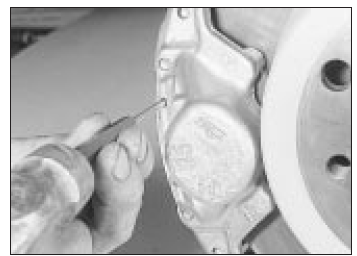Opel Corsa B 1993–2000 Service and Repair Manual: Rear brake pads - renewal
Warning: Disc brake pads must be renewed on both rear wheels at the same time. Never renew the pads on only one wheel as uneven braking may result. Also, the dust created by wear of the pads may contain asbestos, which is a health hazard. Never blow it out with compressed air and don't inhale any of it. An approved filtering mask should be worn when working on the brakes. DO NOT use petroleum-based solvents to clean brake parts. Use brake cleaner or methylated spirit only.
1. Raise the front of the vehicle. If the roadwheels have been balanced on the vehicle (new vehicles are balanced this way in production) then mark the relative position of the roadwheel to the hub so that it can be aligned correctly when refitting.
2. Inspect the thickness of the friction material on each pad. If any one is at or below the specified minimum, renew the pads as an axle set (four pads) in the following way.
3. Using a pin punch, drive out the two pad retaining pins from the outside towards the middle of the vehicle (see illustration).
Recover the spring.

Driving out a rear disc pad retaining pin
4. Remove the pads from the caliper. If they are tight, use a slide hammer or grip them with self-locking pliers.
5. Clean the caliper with a soft wire brush, paying attention to the warning at the beginning of this operation.
6. In order to accommodate the new thicker pads, the caliper piston must be depressed fully into its cylinder using a flat bar of metal such as a tyre lever. The action of depressing the piston will cause the fluid in the reservoir to rise, so anticipate this by syphoning some off using an old (clean) hydrometer or similar.
7. Inspect the brake disc for deep grooving, scoring or cracks. Renew the disc, or have it refinished if this is possible, if such damage is found. Excessive run-out may be caused by wheel bearing play, so bearing adjustment should be checked before assuming that the disc is at fault.
8. Apply a little disc brake anti-squeal or anti-seize compound to the backs of the new pads, and to the sides of the backplate. Be careful not to get any on the friction surface.
9. Insert the pads into the caliper with the friction material towards the disc. Fit one retaining pin (from the inside towards the outside) and tap it home. Hook one end of the spring under the pin (see illustrations).

Fitting a rear pad

Hooking the spring under one
retaining pin
10. Fit the other pin and tap it home, holding the other end of the spring down with a screwdriver so that the pin passes over it.
11. Repeat the operations on the opposite brake.
12. Refit the roadwheels and lower the vehicle.
13. Apply the footbrake hard several times to position the pads against the discs.
14. Top-up the fluid reservoir to the correct level.
15. New brake pads need to be carefully bedded in and, where possible, heavy braking should be avoided during the first 120 miles (200 km).
 Front brake pads - renewal
Front brake pads - renewal
Warning: Renew both sets of
front brake pads at the same
time - never renew the pads on
only one wheel as uneven
braking may result. Note that the dust
created by wear of the pads may contain
as ...
 Rear brake shoes - renewal
Rear brake shoes - renewal
Warning: Drum brake shoes
must be renewed on both rear
wheels at the same time - never
renew the shoes on only one
wheel as uneven braking may result. Also,
the dust created by wear of the shoes ...
See also:
Opel Corsa Owners Manual. Exterior lighting
Turn light switch:
= Off.
= Side lights.
= Headlights.
Press
= Front fog lights.
= Rear fog lights.
Lighting.
Headlight flash, high beam and
low beam
headlight flash = pull lever.
...
